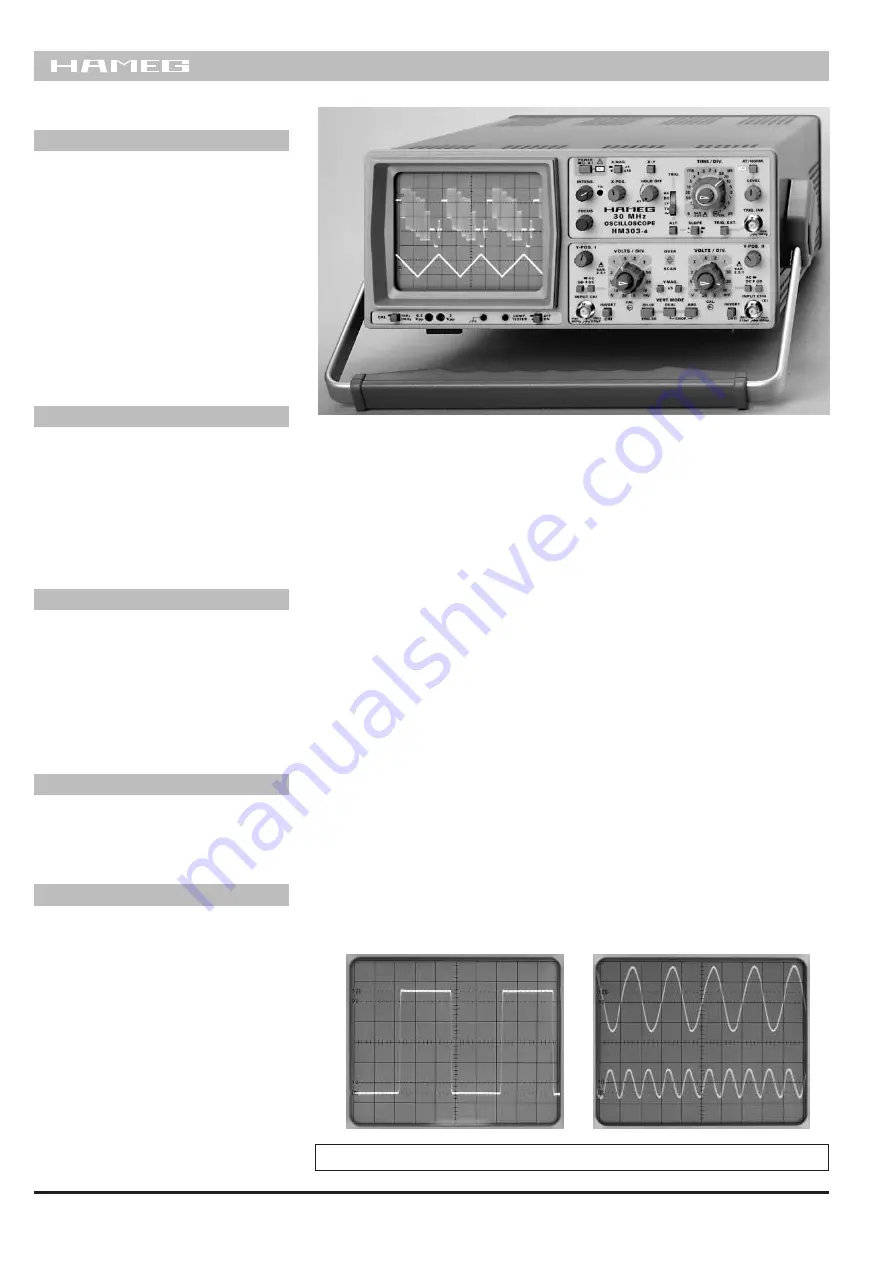
30MHz Standard Oscilloscope HM 303
Accessories supplied: Line cord, Operators Manual, 2 Probes 1:1/10:1
Screen photo of 1 MHz square wave signal
Screen photo of 50 and 100MHz
sine wave with alternate triggering
The new
HAMEG
HM303
oscilloscope succeeds the HM203 (over 170,000
sold worldwide). The bandwidth has been extended from 20 to
30MHz
, the sweep
rate increased to
10ns/div.
and improvements added to the already legendary
HAMEG
auto triggering system. The
HM303
is the ideal instrument for waveform
display in the
DC
to
70MHz
frequency range.
A key feature of this oscilloscope is the vertical amplifier's pulse fidelity, limiting
overshoot to only 1%. The
HM303
offers a special fast rise time,
1kHz/1MHz
Calibrator
permitting high quality probe compensation across the entire frequency
range to ensure probe-tip thru to display integrity. An
Overscan Indicator
assists
in vertical display amplitude and position adjustment.
The
HM303
is capable of triggering on input waveforms over
100MHz
and on
signal levels as small as 0.5 division.
Alternate triggering
mode enables the
display of two asynchronous signals simultaneously. An active
Video Sync-
Separator
permits detailed examination of complex TV signal inputs. A well
proven, built-in
component tester
is now equipped with a stabilized measuring
voltage. The use of a switching type of power supply minimizes both weight and
power consumption and universally accepts a wide range of input power line
voltages, without the requirement to change jumpers or switch positions. The
HM303's
CRT is fully
mu-metal shielded
against outside magnetic fields.
HAMEG
is setting new
price/performance
breakthroughs with the introduction
of this fine oscilloscope. This performance packed scope will tempt all users to run
it through its paces.
Dual Channel, DC to 30MHz, 1mV/div.; Overscan Indicator
Time Base: 0.5s to 10ns/div.; Variable Holdoff; Alternate Triggering
Triggering: DC-100MHz; Auto Peak to Peak; Active TV-Sync-Separator
Additional Features: Component Tester, 1kHz/1MHz Calibrator
OSCILLOSCOPES
Specifications
Vertical Deflection
Operating modes:
Channel I or II separate,
both Channels (alternated or chopped),
(Chopper frequency approx. 0.5MHz).
Sum
or
difference
with Ch. I and Ch. II
(both channels invertable).
XY-Mode:
via channel I and channel II
Frequency range:
2xDC to 30MHz (
−
3dB)
Risetime: <12ns.
Overshoot
≤
1%.
Deflection coefficients:
12 calibrated steps
from 5mV/div. to 20V/div. (1-2-5 sequence)
with variable 2.5:1 up to
50V/div.
Accuracy in calibrated position: ±3%
Y-expansion x5
(calibrated) to
1mV/div.
(±5%)
in the frequency range from DC - 10MHz (–3dB)
Input impedance:
1M
Ω
II 20pF.
Input coupling: DC-AC-GD (ground).
Input voltage: max. 400V (DC + peak AC).
Triggering
Automatic:
(peak to peak)
<20Hz-100MHz
(
≤
0.5div.)
Normal with level control:
DC-100MHz
(
≤
0.5div.)
ALT. Triggering; LED indicator
for trigger action
Slope: positive or negative,
Sources: Channel I or II, CH. I alternating CH II,
line, external
Coupling:
AC
(10Hz to 100MHz),
DC
(0 to 100MHz),
LF
(0 to 1.5kHz)
Active TV-Sync-Separator
(pos. and neg.)
External:
≥
0.3V
p-p
from 30Hz to 30MHz
Horizontal Deflection
Time coefficients:
20 calibrated steps
from 0.2s/div. - 0.1µs/div. in 1-2-5 sequence
Accuracy in calibrated position: ±3%.
Min. speed incl. variable 2.5:1: 0.5s/div.
with X-Mag. x10: ±5%; 10ns/div.: ±8%
Holdoff time:
variable to approx. 10:1
Bandwidth X-amplifier:
0-3MHz (
−
3dB).
Input X-Amplifier via Channel II,
(sensitivity see Channel II specification)
X-Y
phase shift: <3° below 220kHz.
Component Tester
Test voltage:
approx. 6V
rms
(open circuit).
Test current:
approx. 5mA
rms
(shorted).
Test frequency:
approx. 50Hz
Test connection: 2 banana jacks 4mm
∅
One test lead is grounded (Safety Earth)
General Information
CRT:
D14-364GY/123 or ER151-GH/-,
6" rectangular screen (8x10cm)
internal graticule
Acceleration voltage:
approx 2000V
Trace rotation:
adjustable on front panel
Calibrator:
square-wave generator (t
r
<4ns)
≈
1kHz / 1MHz; Output: 0.2V ±1% and 2V
Line voltage: 100-240V AC ±10%, 50/60Hz
Power consumption:
approx. 36 Watt at 50Hz.
Min./Max. ambient temperature:
−
10°C...+40°C
Protective system:
Safety class I (IEC 1010-1)
Weight: approx. 5.6kg, color: techno-brown
Cabinet:
W
285,
H
125,
D
380 mm
Lockable tilt handle
Subject to change without notice.
3/95





































